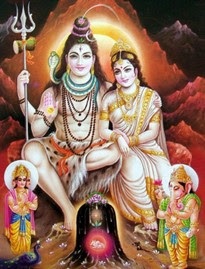From Namam 684
to 741 the glories of the Divine Mother are discussed.
The Divine Mother loves Guru. Here the Guru referred is Shiva, (Dakshinamoorthy) the Ultimate Guru of the universe. Guru also means the Gurus of devas and asuras (Prahaaspthi and Shukra). Finally, the Guru the entire lineage of the Gurus from Sadashiva to Aadi Shankara and to our present Guru. (Guru Parampara).
The Divine Mother loves the universal Guru, Shiva being Her spouse. The people who have knowledge, skill, and strength, who perform sacrifices are the Guru to guide the disciples. Shiva is in such a coveted position, and She is loves Him. The ultimate Guru Maheswara does not have anybody equal to Him in every aspect. Likewise, there is no comparable soul to the Divine Mother. Shiva and the Divine Mother are praised for their ultimate status. She is in such praiseworthy form; She is called the ‘Guru Priya’.
Shiva is the Guru Prahaspathi. His spouse is Thara Devi (one form of the Divine Mother); She is in Sri Vidya. She accepts His devotion to Her and She is beloved by Him. The universal ultimate Guru is Shiva. She is beloved by Him. The one who teaches mantras to us is called the Guru; She is liked by such Gurus. As the spouse of Guru Shiva, She is called ‘Guru Priya’.
As the sacred percept says, ‘Guru is the Supreme Brahman itself.’ The Divine Mother is the Maya who becomes dear to the Brahman with the form, who is engaged in creation.
The Divine Mother loves all our lineage of Gurus. She is in their form as well as the form of their spouses (Guru patnis). Therefore, it is essential to respect and worship one’s Gurus and their spouses.
The Divine Mother is beloved by
Universal
Guru Shiva; She is Guru Priya.
CN
Nachiappan
Singapore, 16 January 2022;
updated 26 March 2025.
References:
1.
The Thousand
Names of the Divine Mother published in English by Mata Amritanandamayi Center,
San Ramon, California, USA, with Commentary by T. V Narayana Menon
2.
Shri Lalitha
Sahasranama Stostram published in Tamil by N. Ramaswami Iyer charities’
societies, Trichirapalli, India, with Commentary by C. V. Radhakrishna Sastry.
3.
The Lalitha
Sahasranamam published in Tamil by Shri Ramakrishna Thapovanam,
Thiruipparaithurai, Trichy District, Tamilnadu, India with commentary by
Shrimath Swami Sithbavandar


No comments:
Post a Comment